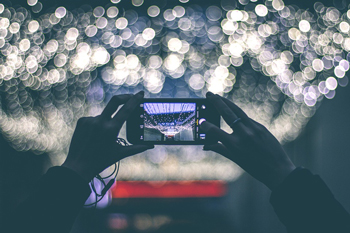By SAM FISCHER
More and more smartphones today are coming out with cameras that are incredibly functional. A dedicated camera still will outdo smartphone cameras in most aspects. But even a consummate photographer like myself isn’t ashamed to take a quick smartphone photo anymore.
Camera features to look for when selecting a phone:
Camera resolution is important but not as crucial as manufacturers want us to believe. Most premium smartphone cameras sit at around 12 megapixels of resolution currently. That seems somewhat disappointing compared to the to interchangeable lens cameras.

Screen choice is something that I also have to give lots of thought to. The Retina screens of the latest iPhone models have a much greater pixel density (326 ppi) than many other smartphones.
The sharpness of the display makes my images look that much better. The Google Pixel is even more impressive at 424 ppi.
Image stabilization is necessary here because I do most of my shooting handheld. Tripods are the best form of image stabilization. But the whole point of smartphone photography is having a portable device that can instantly snap a great picture.
Many smartphones have optical image stabilization built in. OIS uses hardware lens elements to correct for hand movement, which can cause blur in photos. Digital image stabilization is often found in lower-end smartphones. While it’s better than no IS, smartphone photographers really should try for OIS using cameras.
Lastly, battery life is a big deal here because smartphones are hybrid devices. I’m using my phone to make calls, play games, check email, AND take pictures now. That means my battery is continuously used.
For the smartphone photographer, a battery case makes even more sense. They do double duty in protecting my phone and providing extra battery life for photography.
Apps for composition:
There are dozens, if not hundreds, of great smartphone apps. Here are a few of my favorites.
- My Tide Times is an incredibly useful app for both Android and iOS photographers. I happen to love outdoor photography. And knowing exactly when I should arrive by the water to achieve the effect I want is invaluable. The app also provides 7-day weather forecasts. So even if I don’t plan to go to the beach, I can use My Tide Times to plan outdoor shoots.
- Simple DoF calculator is for iPhone user only. It takes a lot of the guesswork out of figuring out exactly what effect I’ll achieve from a particular depth of field. For those who don’t know, depth of field is how much of a given scene is in sharp focus.
- Lapse It Pro Edition works with both Android and iOS devices. It lets photographers create time-lapse movies, which is a feature found in many cameras but not every smartphone. Time lapses are great for events that take place over an extended period, such as a seed germinating or clouds crossing the sky. All I need is a tripod, good battery life, and time.
- Adobe Lightroom is one of the best image editing programs around. And it’s available for both Android and iOS devices. RAW editing and most of the more powerful features are now usable on my smartphone. Lightroom also has a camera function directly built in, allowing quick import photos taken into the program.
Conclusion:
The leading advantage smartphones offer over dedicated cameras is convenience. I’m always going to have my phone on me. And if I know I’ll often have the chance to capture great images it’s a good idea to have a capable camera handy as well.
So any prospective smartphone photographer should get to know the features of their camera phone well before deciding to buy the newest model. Just like regular cameras, the specifications matter more than ever.
Happy shooting!
Article contributed by Sam Fischer from the Iconic Camera blog, an online photography resource which helps anyone take amazing photos. Follow Sam on Pinterest.


